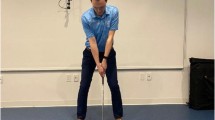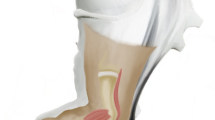Abstract
Golf injuries to the lower back and elbow are common problems in both the professional and amateur player, and any information regarding the successful treatment of these injuries has important implications for the medical practitioner. This paper presents the successful management and outcome of two case studies associated with low back pain and lateral epicondylitis in golf.
Exercise therapy and conditioning has been shown to be an effective treatment modality for these two types of injury. In particular, a dynamic exercise programme which incorporates golf functional rehabilitation, is a modern and accepted method by both the patient and the clinician.
Effective programmes need to be golf-specific to maintain the interest of the participant and yet at the same time they need to be able to accommodate other factors such as age, gender and the level of the golfer. Furthermore, it is critical that the clinical practitioner has a fundamental knowledge of normal swing mechanics and a working knowledge of the musculoskeletal requirements needed to swing a golf club.
In the case of the lower back injury, evaluationwas based on detailed computer tomography and centred on the conditioning of the transversus abdominis muscle. Although this muscle is not considered to be paraspinal, it has particularly important implications in the maintenance of spinal stability so that other more specific golf functioning exercises and rehabilitation can be performed. For the case study of lateral epicondylitis detailed evaluation and consideration of neuropathywas an important factor in the diagnostic process. In part, it was necessary to deviate from conventional treatment to produce an effective outcome. A comprehensive resistance-strength-training programme and golf functional ‘hitting’ programme was used to treat the problem.
The conformity by the patient to complete the exercise regimen has been an issue of concern for clinicians managing and treating golf-related problems. Many golfers are ‘fanatical’ and unless they can see that by continuing the programme their injury will be overcome, it is difficult trying to restrict their time on the golf course. The two case studies described in this article highlight how an extensive and dynamic golf functional programme could be used as an effective method for managing and preventing golf injuries.





Similar content being viewed by others
References
McCarroll JR. The frequency of golf injuries. Clin Sports Med 1996; 15 (1): 1–7
Lindsay DM, Horton JF, Vandervoort AA. A review of injury characteristics, aging factors and prevention programmes for the older golfer. Sports Med 2000; 30 (2): 89–103
Sherman CA, Finch CF. Preventing injuries to competitive and recreational adult golfers: what is the evidence? J Sci Med Sport 2000; 3 (1): 65–78
Grimshaw PN, Burden AM. Case report: reduction of low back pain in a professional golfer. Med Sci Sports Exerc 2000; 32 (10): 1667–73
Horton JF, Lindsay DM, Macintosh BR. Abdominal muscle activation of elite male golfers with chronic low back pain. Med Sci Sports Exerc 2001; 33 (10): 1647–54
Bates BT. Single-subject methodology: an alternative approach. Med Sci Sports Exerc 1996; 28 (5): 631–8
Reboussin DM, Morgan TM. Statistical considerations in the use and analysis of single-subject designs. Med Sci Sports Exerc 1996; 28 (5): 639–44
Yin R. Case study research: design and methods. 2nd ed. Newbury Park (CA): Sage, 1994
McCarroll JR, Rettig AC, Shelbourne KD. Injuries in the amateur golfer. Physician Sportsmed 1990; 19: 122–6
Batt ME. A survey of golf injuries in amateur golfers. Br J Sports Med 1992; 26 (1): 63–5
Batt ME. Golfing injuries: an overview. Sports Med 1993; 16 (1): 64–71
McCarroll JR, Mallon WJ. Epidemiology of golf injuries. In: Stover CN, McCarroll JR, Mallon WJ, editors. Feeling up to par: medicine from tee to green. Philadelphia (PA): F.A. Davis, 1994: 9–13
Thériault G, Lacoste E, Gadoury M, et al. Golf injury characteristics: a survey from 528 golfers [abstract]. Med Sci Sports Exerc 1996; 28: S389
Nicholas JJ, Reidy M, Oleske DM. An epidemiological survey of injury in golfers. J Sports Rehabil 1998; 7: 112–21
Thériault G, Lachance P. Golf injuries: an overview. Sports Med 1998; 26 (1): 43–57
Finch C, Sherman C, James T. The epidemiology of golf injuries in Victoria, Australia: evidence from sports medicine clinics and emergency department presentations. In: Farrally MR, Cochran AJ, editors. Science and golf III: Proceedings of the World Scientific Congress of Golf; 1998 Jul 20–24; St Andrews. Champaign (IL): Human Kinetics, 1999: 73–82
McNicolas MJ, Neilsen A, Knill-Jones RP. Golf injuries in Scotland. In: Farrally MR, Cochran AJ, editors. Science and golf III: Proceedings of the World Scientific Congress of Golf; 1998 Jul 20–24; St Andrews. Champaign (IL): Human Kinetics, 1999: 65–72
Sugaya H, Tsuchiya A, Moriya H, et al. Low back injury in elite and professional golfers: an epidemiologic and radiographic study. In: Farrally MR, Cochran AJ, editors. Science and golf III: Proceedings of the World Scientific Congress of Golf; 1998 Jul 20–24; St Andrews. Champaign (IL): Human Kinetics, 1999: 83–91
Pink MM, Jobe FW, Yocum LA, et al. Preventative exercises in golf: arm, leg, and back. Clin Sports Med 1996; 15 (1): 147–62
Hartman CA, Hartman DA, Jones MT. Back injuries in golfers: a simple preventative program. Athlet Ther Today 1998 Jul: 44–50
Fradkin AJ, Finch CF, Sherman CA. Warm up practices of golfers: are they adequate? Br J Sports Med 2001; 35 (2): 125–7
Mallon WJ, Colosimo AJ. Acromioclavicular joint injury in competitive golfers. J South Orthop Assoc 1995; 4 (4): 277–82
Jobe FW, Pink MM. Shoulder pain in golf. Clin Sports Med 1996; 15 (1): 55–63
Spinner RJ, Speer KP, Mallon WJ. Avulsion injury to the cojoined tendons of the latissimus dorsi and teres major muscles. Am J Sports Med 1998; 26 (6): 847–9
Read MTF. Case report: stress fracture of the rib in a golfer. Br J Sports Med 1994; 28 (3): 206–7
Orava S, Kallinen M, Aito H, et al. Stress fractures of the ribs in golfers: a report of 5 cases. Scand J Med Sci Sports 1994; 4: 155–8
Lord MJ, Ha KI, Song KS. Stress fractures of the ribs in golfers. Am J Sports Med 1996; 24 (1): 118–22
Sinha AK, Kaeding CC, Wadley GM. Upper extremity stress fractures in athletes: clinical features of 44 cases. Clin J Sport Med 1999; 9 (4): 199–202
Glazebrook MA, Curwin S, Islam MN, et al. Medial epicondylitis: an electromyographic analysis and an investigation of intervention strategies. Am J Sports Med 1994; 22 (5): 674–9
Kohn HS. Prevention and treatment of elbow injuries in golf. Clin Sports Med 1996; 15 (1): 65–83
Clancy Jr WG, Hagan SV. Tendinitis in golf. Clin Sports Med 1996; 15 (1): 27–35
Simunovic Z, Trobonjaca T, Trobonjaca Z. Treatment of medial and lateral epicondylitis-tennis and golfer’s elbow with low level laser therapy: a multicenter double blind, placebo controlled clinical study on 324 patients. J Clin Laser Med Surg 1998; 16 (3): 145–51
Krischek O, Hopf C, Nafe B, et al. Shock-wave therapy for tennis and golfer’s elbow - 1 year follow-up. Arch Orthop Trauma Surg 1999; 119 (1–2): 62–6
Stockard AR. Elbow injuries in golf. J Am Osteopath Assoc 2001; 101 (9): 509–16
Murray PM, Cooney WP. Golf induced injuries of the wrist. Clin Sports Med 1996; 15 (1): 85–109
Koskinen SK, Mattila KT, Alanen AM, et al. Stress fracture of the ulnar diaphysis in a recreational golfer. Clin J Sport Med 1997; 7 (1): 63–5
Abe Y, Kuwata N, Doi K, et al. Wrist pain with triangular fibrocartilage thickening. Arch Orthop Trauma Surg 1999; 119 (1–2): 98–9
Walsh JJ, Bishop AT. Diagnosis and management of hamate hook fractures. Hand Clin 2000; 16 (3): 397–403
Hosea TM, Gatt Jr CJ. Back pain in golf. Clin Sports Med 1996; 15 (1): 37–53
Guten GN. Knee injuries in golf. Clin Sports Med 1996; 15 (1): 111–28
Hame SL, Kohler-Ekstrand C, Ghiselli G. Acute bucket-handle tear of the medial meniscus in a golfer. Arthroscopy 2001; 17 (6): 1–3
Pietrocarlo TA. Foot and ankle considerations in golf. Clin Sports Med 1996; 15 (1): 129–46
Riddoch J, Lennon S. Single subject experimental design: one way forward? Physiotherapy 1994; 80: 762–7
Sim J. The ethics of single-subject (n = 1) research. Physiother Theory Pract 1994; 10: 211–22
McCarroll JR, Gioe TJ. Professional golfers and the price they pay. Physician Sportsmed 1982; 10 (7): 64–70
Kendall FP, McCreary EK. Muscles: testing and function. 3rd ed. Baltimore (MD): Williams and Wilkins, 1983
Hodges PW, Cresswell AG, Daggfeldt K, et al. An in vivo measurement of the effect of intra-abdominal pressure on the human spine. J Biomech 2001; 34 (3): 347–53
Bigos SJ, Bowyer OR, Braen GR, et al. Acute low back pain problems in adults: clinical practice guideline. No. 14. Rockville (MD): AHCPR, 1994. Publication No. 95–0642
Bogduk N. Evidence-based clinical guidelines for the management of acute low back pain. Callaghen (NSW): University of Newcastle, Australia, 1999
Hodges PW, Cresswell AG, Thorstensson A. Perturbed upper limb movements cause short-latency postural responses in trunk muscles. Exp Brain Res 2001; 138 (2): 243–50
Hodges PW. The effect of the motor system in spinal pain: implications for rehabilitation of the athlete following lower back pain. J Sci Med Sport 2000; 3 (3): 243–53
Hodges PW, Jull GA. Does strengthening the abdominal muscles prevent low back pain? J Rheumatol 2000; 27 (9): 2286–8
Hides JA, Jull GA, Richardson CA. Long term effects of specific stabilizing exercises for first-episode low back pain. Spine 2001; 26 (11): E243–8
Jull GA, Richardson CA. Motor control problems in patients with spinal pain: a new direction for therapeutic exercise. J Manipulative Physiol Ther 2000; 23 (2): 115–7
Verhaar J, Walenkamp G, Kester A, et al. Lateral extensor release for tennis elbow: a prospective long term follow-up study. J Bone Joint Surg Am 1993; 75: 1034–43
Acknowledgements
The authors would like to thank Michael Dale (Biomechanics Laboratory, University of South Australia) and Alison Downie (‘Care for Sport Ltd’ Sports Medicine and Physiotherapy Clinic, Edinburgh, Scotland, UK) for their assistance at various stages in the preparation of this article.
The authors received no funding for the preparation of this article and have no conflicts of interest.
Author information
Authors and Affiliations
Corresponding author
Rights and permissions
About this article
Cite this article
Grimshaw, P., Giles, A., Tong, R. et al. Lower Back and Elbow Injuries in Golf. Sports Med 32, 655–666 (2002). https://doi.org/10.2165/00007256-200232100-00004
Published:
Issue Date:
DOI: https://doi.org/10.2165/00007256-200232100-00004




